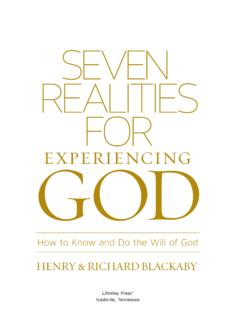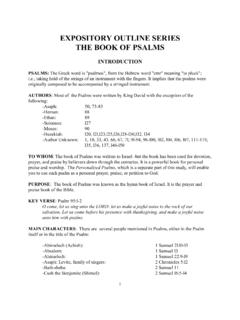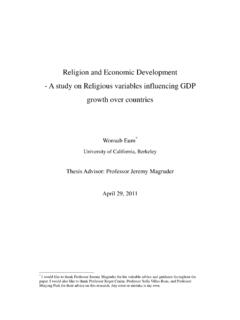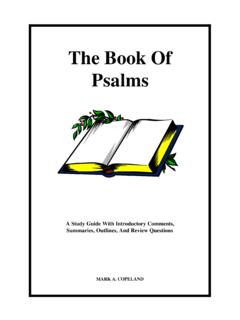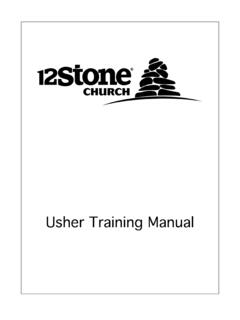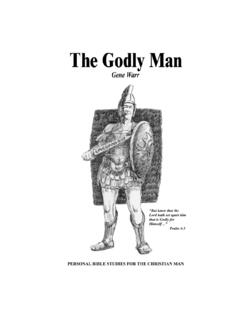Transcription of The Mandukya Upanishad - Sankaracharya
1 The Mandukya Upanishad by Swami Krishnananda, The Divine Life Society, Sivananda Ashram The Mandukya Upanishad by Swami Krishnananda The Divine Life Society Sivananda Ashram, Rishikesh, India PUBLISHERS' PREFACE The present publication consists of the lectures, delivered extempore, by the Swamiji, in the year 1968, on the philosophy and teachings of the Mandukya Upanishad . The First section of the discourses expounds the meaning of the great mystical symbol, Om, or Pranava, as a connotation as well as denotation of the Absolute. The Second section explains the nature of the Universal Being, Vaisvanara, or Virat, as delineated in the Upanishad . The Third section propounds the mystery of Dream and Sleep, as also the cosmic counterpart of this state, namely, Hiranyagarbha, the Divine Immanent Being.
2 The Fourth section is an exposition of the profound significance of Sleep in the interpretation of the nature of the Spirit in man. The Fifth section is centred round the great theme, the nature of Isvara, the Supreme God of the Universe. The Sixth section concerns itself with the majestic character of Reality as such, the Absolute, as the Transcendent Presence. The Seventh section is the concluding summary, devoted to an explanation of the harmony between the constituents of Om, or Pranava, and the four states of Consciousness, which forms the subject of the Upanishad . Herein, the students of Philosophy and Spiritual Life will find presented the quintessence of the acme of thought and experience reached in ancient times, - the upanishads . (1 of 61)The Mandukya Upanishad by Swami Krishnananda, The Divine Life Society, Sivananda AshramTHE DIVINE LIFE SOCIETY Shivanandanagar 16th November, 1996.
3 THE MANDUKYOPANISHAD Om! Bhadram karnebhih s'rnuyama devah Bhadram pasyemakshabhiryajatrah Sthirairangaistushtuvamsastanubhir Vyasema devahitam yadayuh Svasti na indro vriddhasravah Svasti nah pusha visvavedah Svasti nastarkshyo arishtanemih Svasti no brihaspatirdadhatu Om Santih; Santih; Santih Om. Shining Ones! May we hear through our ears what is auspicious. Ye, fit to be worshipped! May we see with our eyes what is auspicious. May we, endowed with body strong with limbs, offering praise, complete the full span of life bestowed upon us by the divine beings. May Indra, of enhanced fame, be auspicious unto us. May Pushan, who is all-knowing, be auspicious unto us. May Tarkshya, who is the destroyer of all evils, be auspicious unto us. May Brihaspati bestow upon us auspiciousness!
4 Om Peace! Peace! Peace! (2 of 61)The Mandukya Upanishad by Swami Krishnananda, The Divine Life Society, Sivananda Ashram 1. Omityetadaksharamidam sarvam, tasyopavy akyanam, bhutam bhavatbhavishyaditi sarvamomkaraeva; Yaccanyat trikalatitam tadapyomkara eva. OM! - This Imperishable Word is the whole of this visible universe. Its explanation is as follows: What has become, what is becoming, what will become, - verily, all of this is OM. And what is beyond these three states of the world of time, - that too, verily, is OM. 2. Sarvam hyeted brahma; ayamatma brahma; soyamatma chatushpat. All this, verily, is Brahman. The Self is Brahman. This Self has four quarters. 3. Jagaritasthano bahihprajnah saptanga ekonavimsati- mukhah sthulabhug vaisvanarah prathamah padah.
5 The first quarter is Vaisvanara. Its field is the waking state. Its consciousness is outward-turned. It is seven-limbed and nineteen-mouthed. It enjoys gross objects. (3 of 61)The Mandukya Upanishad by Swami Krishnananda, The Divine Life Society, Sivananda Ashram 4. Svapnasthano'ntah-prajnah saptanga ekonavimsati- mukhah praviviktabhuk taijaso dvitiyah padah. The second quarter is Taijasa. Its field is the dream state. Its consciousness is inward-turned. It is seven-limbed and nineteen-mouthed. It enjoys subtle objects. 5. Yatra supto na kancana kaman kamayate; na kancana svapnam pasyati tat sushuptam. Sushuptasthana ekibhutah prajnanaghana evanandamayo hyanandabhuk cetomukhah prajnas-tritiyah padah. The third quarter is Prajna, where one asleep neither desires anything nor beholds any dream: that is deep sleep.
6 In this field of dreamless sleep, one becomes undivided, an undifferentiated mass of consciousness, consisting of bliss and feeding on bliss. His mouth is consciousness. 6. Esha sarvesvara esha sarvajna esho'ntaryamyesha yonih sarvasya prabhavapyayau hi bhutanam. This is the Lord of All; the Omniscient; the Indwelling Controller; the Source of All. This is the beginning and end of all beings. (4 of 61)The Mandukya Upanishad by Swami Krishnananda, The Divine Life Society, Sivananda Ashram7. Nantah-prajnam, na bahih prajnam, no'bhayatah- prajnam, na prajnanaghanam, na prajnam, na-aprajnam; adrishtam-avyavaharayam-agrahyam-alaksha nam- acintyam-avyapadesyam-ekatmapratyayasara m, prapancopasarnam, santam, sivam-advaitam, caturtham manyante, sa atma sa vijneyah.
7 That is known as the fourth quarter: neither inward-turned nor outward-turned consciousness, nor the two together; not an indifferentiated mass of consciousness; neither knowing, nor unknowing; invisible, ineffable, intangible, devoid of characteristics, inconceivable, indefinable, its sole essence being the consciousness of its own Self; the coming to rest of all relative existence; utterly quiet; peaceful; blissful: without a second: this is the Atman, the Self; this is to be realised. 8. So'yamatma-adhyaksharam-Omkaro'dhimatram , pada matra, matrasca pada Akara Ukaro Makara iti. This identical Atman, or Self, in the realm of sound is the syllable OM, the above described four quarters of the Self being identical with the components of the syllable, and the components of the syllable being identical with the four quarters of the Self.
8 The components of the Syllable are A, U, M. (5 of 61)The Mandukya Upanishad by Swami Krishnananda, The Divine Life Society, Sivananda Ashram 9. Jagaritasthano vaisvanaro'karah prathama matra, apteradimatvadvapnoti ha vai sarvan kamanadisca bhavati ya evam veda. Vaisvanara, whose field is the waking state, is the first sound, A, because this encompasses all, and because it is the first. He who knows thus, encompasses all desirable objects; he becomes the first. 10. Svapnasthanastaijasa ukaro dvitiya matrotkarshadu- bhayatvadvotkarshati ha vai jnana-santatim, samanasca bhavati, nasyabrahmavit kule bhavati ya evam veda. Taijasa, whose field is the dream state, is the second sound, U, because this is an excellence, and contains the qualities of the other two.
9 He who knows thus, exalts the flow of knowledge and becomes equalised; in his family there will be born no one ignorant of Brahman. 11. Sushuptasthanah prajno makarastritiya matra miterapiter va, minoti ha va idam sarvam-apitisca bhavati ya evam veda. Prajna, whose field is deep sleep, is the third sound, M, because this is the (6 of 61)The Mandukya Upanishad by Swami Krishnananda, The Divine Life Society, Sivananda Ashrammeasure, and that into which all enters. He who knows thus, measures all and becomes all. 12. Amatrascaturtho'vyavaharyah prapancopasamah sivo'dvaita evamomkara atmaiva, samvisatyatmanatmanam ya evam veda, ya evam Santih; Santih; Santih The fourth is soundless: unutterable, a quieting down of all relative manifestations, blissful, peaceful, non-dual.
10 Thus, OM is the Atman, verily. He who knows thus, merges his self in the Self; - yea, he who knows thus. Om Peace! Peace! Peace! THE PRANAVA OR OMKARA The Vedas, in their form as the Samhitas, constitute an introduction to the subject dealt with in the Vedanta or the upanishads . The upanishads are secret teachings containing wisdom beyond the realm of the earth and revealing proclamations of the great sages of yore on the nature of Reality. Among the upanishads , the Mandukya may be regarded as the most important, and it is aptly said, Mandukyam ekam eva alam mumukshunam vimuktaye - for the liberation of the Mumukshu or seeker the Mandukya alone is enough; and if you are able to understand the true meaning of this single Upanishad , there may not be a necessity to study any other Upanishad , not even the Chhandogya or the Brihadaranyaka, because the theme of the Mandukya Upanishad is a direct approach to the depths of human nature.

